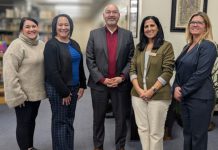GILROY
– Local educators are spending, out of their own pockets,
between $500 and $2,000 a year on teaching materials and supplies,
according to a recent informal survey of El Roble Elementary School
teachers.
GILROY – Local educators are spending, out of their own pockets, between $500 and $2,000 a year on teaching materials and supplies, according to a recent informal survey of El Roble Elementary School teachers.
The expenses accrue despite contributions of $1 million a year from the California Lottery, which was established partly to ease the burdens of public schools and their teachers.
“With all the impending cutbacks (due to the state’s budget crisis), it means we’re probably going to have to spend even more,” El Roble teacher Jan Paterson said.
Teachers can deduct these expenses when they file taxes, and educators can use much of their supplies over multiple school years. However, teachers say if they want to expand their classroom library and keep up with the latest teaching strategies, a yearly investment of $1,000 is anticipated.
Gilroy Teachers Association President Michelle Nelson points out that some subjects are more expensive to teach than others.
“Science for example is an expensive thing to do,” Nelson said. “When you can’t pay for the supplies yourself, you go after a grant but there’s no guarantee you’ll get those funds.”
Since the lottery’s inception in 1985, Gilroy Unified School District has received more than $17 million from lottery proceeds. Last year, 2.26 percent of the district’s unrestricted general fund – money GUSD can use how it wants – came from the state’s lottery.
Most of GUSD’s lottery proceeds have been designated in recent years to fund music instruction and physical education. In addition, each school site receives $12 per student from the lottery, which is used typically for instructional materials.
“That is discretionary money, so each site decides how it will be used,” Assistant Superintendent Lee White said.
For GUSD school board President Jim Rogers, lottery revenue has not met the high expectations he had back in 1985. Rogers looked at lottery as a way for schools to get items like TVs and projectors, “those things you can survive without but certainly enhance a learning atmosphere,” the former GUSD administrator said.
“It’s really not getting us those standout extra items like I thought it would when it started out,” Rogers said. “But it is a million dollars that we would have to come up with some other way if it wasn’t there.”
Despite a $35 billion revenue shortfall, the state will not be allowed to divert lottery money from the schools, White said. The Lottery Act mandates that public education must receive at least 34 percent of the sales revenues taken in each year by the lottery.
That mandate has been attained in each of the lottery’s 16 years of operation.
“Because it’s been in place so long, it’s part of the budgeting process and we rely on it,” White said. “But we can’t depend on how much we’ll get because it could be different every year. Lottery revenue is based on lottery sales, and lottery sales depend on many factors. When we have good jackpots, that can drive up the amount we’ll be getting for the year.”














